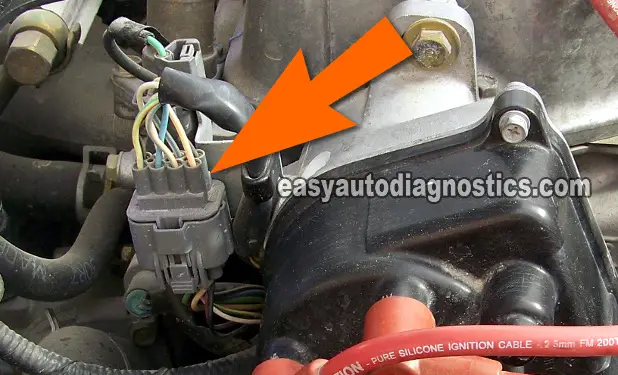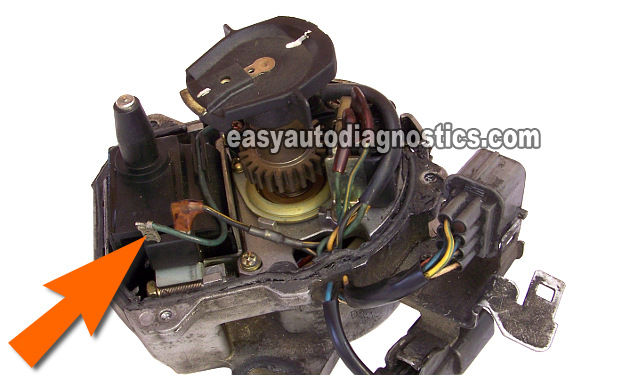TEST 5: Testing The Ignition Coil's Switching Signal
IMPORTANT: If you got a spark result in TEST 3, do not proceed with this test step, or you risk damaging the ignition coil. A spark result in TEST 3 confirms that the switching signal is present (thanks to Randy for the feedback).
If you've reached this point, you have:
One: Checked that none of the four spark plug wires are delivering spark (TEST 1).
Two: Checked that the ignition coil is not sparking and the distributor rotor is turning (when your helper cranked the engine) (TEST 3).
Three: Checked that the ignition coil and the igniter are being fed 10 to 12 Volts DC (TEST 4).
The next step is to find out if the igniter is feeding the ignition coil an activation signal (which I call the switching signal).
The presence of the switching signal is verified using a 12 Volt test light and while the Accord or Civic or Odyssey is being cranked (whatever the test light does with the key ON or OFF does not matter, the results you need to worry about is when the engine is cranking).
 You can see this specific test step done here in this YouTube video (although it involves a 2.0L Honda CR-V, the test steps are very similar): How To Test The Ignition Coil (1999-2001 2.0L Honda CR-V).
You can see this specific test step done here in this YouTube video (although it involves a 2.0L Honda CR-V, the test steps are very similar): How To Test The Ignition Coil (1999-2001 2.0L Honda CR-V).
Here's what you'll need to do:
- 1
Connect the alligator clip of the test light to the battery positive (+) terminal.
- 2
With the probe end of the test light, touch the terminal pointed at by the white arrow in the photo on the right. This terminal is normally labeled with a (-) sign on the ignition coil itself. This is the terminal that feeds the switching signal to the Accord, Civic or Odyssey's ignition coil. Also, the color of this wire is usually blue.
- 3
Have your assistant crank the Accord, or Civic, or Odyssey while you observe the test light.
- 4
If the switching signal is present, the test light will light ON and OFF continuously as long as your assistant is cranking the engine.
That was simple enough, lets interpret the one of two results that this test should give you:
CASE 1: The test light flashed ON and OFF while the engine was cranking. Then the ignition coil is bad, replace it.
Here's why: The flashing ON and OFF of the test light confirms that the Honda's igniter (ignition control module) is receiving its Triggering signal from the ECM (Electronic Control Module=Fuel Injection Computer) and that it's generating the switching signal. Simply put: it's working correctly. So then, if the ignition coil is receiving 12 Volts (which you have already confirmed in TEST 3) and is receiving the switching signal from the igniter- IT HAS TO SPARK. Since it did not, it's bad.
CASE 2: The test light DID NOT flash ON and OFF while the engine was cranking. This test result tells you that the ignition coil is not receiving an activation signal from the igniter.
The next step is to see if the igniter is itself receiving an activation signal from the fuel injection computer. For this test go to: TEST 6: Testing The Igniter For The Triggering Signal to test the igniter itself.
Here's why: The igniter (ignition control module) is the one that creates and provides the switching signal to the ignition coil. It could be bad or maybe it's not receiving the Triggering Signal it needs to generate the switching signal, therefore, we need TEST 6: Testing The Igniter For The Triggering Signal to further investigate this.
TEST 6: Testing The Igniter For The Triggering Signal

In this test, you're gonna' check to see if the ECM (Electronic Control Module = Fuel Injection Computer) is generating and sending the igniter's triggering signal.
As in the previous tests, the tests in this section are performed with the distributor connected to its two connectors. This last test will help you confirm if the igniter (ignition control module -ICM) is bad or not.
NOTE: You can use a digital multimeter or an LED light to test the igniter triggering signal, but you CAN NOT use a test light. If you use a multimeter, it has to be able to read Hertz (Hz) frequency since the signal has to be measured in Hertz. The following test assumes that you're using an LED light.
If you need to buy an LED light, see this page: The LED Light Test Tool And How To Make One.
 You can see this specific test step done here in this YouTube video (although it involves a 2.0L Honda CR-V, the test steps are very similar): How To Test The Ignition Control Module (1999, 2000, 2001 2.0L Honda CR-V).
You can see this specific test step done here in this YouTube video (although it involves a 2.0L Honda CR-V, the test steps are very similar): How To Test The Ignition Control Module (1999, 2000, 2001 2.0L Honda CR-V).
OK, let's get testing:
- 1
With an appropriate tool (like a wire-piercing probe) pierce the yellow with green stripe wire of the 7 wire distributor connector (to see what this tool looks like, go here: Wire Piercing Probe).
- 2
Remember, this test is done with both connectors connected.
- 3
Place the red lead of the LED to a 12 Volt power source.
- 4
Connect the black lead of the LED to the tool that's piercing the yellow with green stripe wire.
- 5
Have your assistant crank the Civic (Accord, CRV, or Odyssey) while you observe the LED light.
- 6
If the triggering signal is present, the LED light will flash ON and OFF continuously as long as your assistant is cranking the engine.
You're gonna' get one of the 2 results: (1) The LED light will flash ON and OFF or (2) The LED light will NOT flash ON and OFF. Let's analyze each result in more detail below:
CASE 1: The LED light flashed ON and OFF while the engine was cranking. Then the ECM is generating and sending the triggering signal to the igniter (ignition control module). Replace the igniter.
Here's why: Up to this point you have verified that:
- None of the four spark plug wires are delivering spark (TEST 1).
- The ignition coil is not sparking and the distributor rotor is turning (when your helper cranked the engine) (TEST 3).
- The igniter and the ignition coil are being fed 10 to 12 Volts DC (TEST 4).
- That the igniter is NOT activating the ignition coil with a switching signal (TEST 5).
- That the igniter IS getting a triggering signal from the fuel injection computer (this test step).
So then, taking all of the above into account the igniter HAS to create and send the switching signal for the ignition coil to activate and start sparking. Since it isn't, then you and I can conclude that the igniter is bad and needs to be replaced.
CASE 2: The LED light DID NOT flash ON and OFF while the engine was cranking. Then the ECM is NOT generating and sending the triggering signal to the igniter (ignition control module).
The most likely causes are either one or several of the cam/crank position sensors within the distributor have gone bad or there's an open in this circuit.
Although testing the two above mentioned causes are beyond the scope of this article, you have now eliminated the following as the causes of your Honda Accord's, or Civic's, or Odyssey's no-start:
- Igniter (ignition control module).
- Ignition coil.
- Distributor cap and rotor.
- Spark plug wires.
- Main relay.
More Honda Tutorials
Hondas are some of the easier cars to work on and troubleshooting them isn't complicated either, so if this tutorial helped, checkout some of these others:
- How To Troubleshoot A No Start (Honda 2.2L, 2.3L) (at: troubleshootmyvehicle.com).
- How To Test For A Blown Head Gasket (Honda 2.2L, 2.3L) (at: troubleshootmyvehicle.com).
- How To Test A Misfire Condition (Honda 2.2L, 2.3L) (at: troubleshootmyvehicle.com).
- How To Find A Bad Fuel Injector (Case Study) (at: troubleshootmyvehicle.com).
- How To Test For A Broken Timing Belt (Honda 2.2L, 2.3L) (at: troubleshootmyvehicle.com).
On YouTube, check out my following videos:
- How To Test The Ignition Coil (1999-2001 2.0L Honda CR-V) (at YouTube).
- How To Test The Ignition Control Module (1999, 2000, 2001 2.0L Honda CR-V) (at YouTube).
- How To Test The Fuel Pump (1997-2001 2.0L Honda CR-V) (at: YouTube).

If this info saved the day, buy me a beer!



